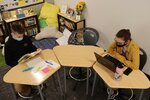Ruthie Biebesheimer, Cascade High School Correspondent
Last school year was unprecedented, crazy, chaotic, and abnormal. Despite all the changes, Cascade School District's teachers managed to continue providing a high-quality education for every student in the district as they simultaneously navigated online and hybrid schooling. From March 17, 2020, to January 18, 2021, all students participated in online school. Starting January 19, 2021, students and teachers began a hybrid school schedule that continued until the end of the school year.
These changes created many difficulties for students and teachers alike. Coming back to completely in-person school this August was a highly anticipated event for everyone. Other than the obvious health and safety protocols in effect to keep students and staff safe, the “new normal” has shifted. The year of online/hybrid learning may have officially passed, but it has resulted in many long-term changes.
The pandemic forced school district employees to quickly adapt to using online learning platforms in an effective manner. While daily health screening checks may be a thing of the past, it would appear many of these platforms are here to stay.
Superintendent, Dr. Tracey Beckendorf-Edou, explained that the Cascade School District “moved really quickly during the pandemic to using Seesaw for grades K-2 and Canvas for grades 3-12. Especially the use of Canvas has already been continuing this school year, and I think it’s helpful overall.”
For the younger students, Peshastin-Dryden Elementary School Principal, Ms. Emily Ross, shared that Seesaw is used for “student and parent communication” and ‘Smore is used for “parent communication through email and text.”
At the high school, many teachers have continued to use Canvas for a variety of reasons: Canvas can be used to post assignments in an easy-to-access fashion, share resources, and keep students in the loop. Students have access to Canvas on any device with internet capabilities. Parents can oversee student progress by using the canvas app, and teachers also have easy access to grading and communication within these platforms.
CHS Spanish teacher, Ms. Angelita Guzman plans to continue the use of certain aspects of online school in the future. I enjoy “the streamlined use of Canvas,” she said. “If we all use it, students will just grow accustomed to using it and will develop their skills of time management and organization, which will make them better equipped to be successful after high school.”
These programs were all quickly put into action as a necessity last school year, due to quarantine mandates, but have paved the way for better communication and organization throughout the district.
These various learning platforms are likely to remain a part of public schooling into the future, because they provide a resource for absentee students. These technologies allow students who are not at school due to illness, quarantine, or traveling for sports/family vacations to stay up to date with classwork and avoid falling behind. The longevity of these resources has been assured, because students can easily access assignments and reach out to their teacher via tools like Canvas and Seesaw.
“It would be great for students who are absent to be able to keep up with their classes by utilizing technology,” explained Principal Emily Ross. In the past, when a student was absent, they typically had to wait until they returned to school to collect work they missed and often fell behind.
Accessibility to online learning tools and programs has been enormously improved. Alpine Lakes Elementary 5th grade teacher and Homelink administrator, Mr. Terry Muscutt stated, “We have more technology tools than ever before. Every student has a device and can take one home.”
Cascade High School senior, Hanalei Alejo shared that while recently working from home, she was able to “easily stay up to date with everything that was happening in the classroom.” The inability for students to directly speak to teachers in person and learn in the classroom, while they work from home, doesn’t prevent them from being able to keep up with their learning, as it could have in previous years. It is likely that online platforms will continue to impact future sick days, snow days, and vacations.
Schooling during the pandemic permitted students more freedom in their schedules and also forced students to be more responsible for their own learning. While some students flourished in the independence of online school, others quickly fell behind. Students who are good self-motivators were able to keep themselves on task when distractions (like TV, phones, family, friends, pets, etc.) were pulling many away from their learning. Online schooling permitted students more freedom to complete schoolwork on their own time, essentially allowing each student to create their own daily schedule.
This year, with in-person school back in full swing, all students are back to the “normal” eight a.m. to three p.m. scheduled class times, and teacher guidance and instruction. The school day might look more normal, but the independence and individual responsibility cultivated through the pandemic experience is something that is sure to be around for years to come.
For many, the return to “normal” is yet another adjustment. Peshastin Dryden Elementary School principal Emily Ross noticed that students need “more support with the ‘school schedule,’” and that by the time the final bell rings, students appear to be exhausted.
“The transition back to full-day school has been a bit hard for all of us because some feel they've lost some of that independence,” explained CHS social studies teacher, Mrs. Renner-Singer.
Cascade High School freshman Hunter Lang expressed that he is glad to be back in person, to be around friends again and be able to, “Get back to normal learning and regular class periods.”
While some students miss the independence of online school, many have learned to appreciate the in-person, student-teacher interaction that they used to take for granted.
A concern with online schooling was the effects of how much learning was happening from behind the screen and a general loss of content. In some classes, students seem to be able to jump right back in to a more normal, hard-copy routine, while other classes seem to be having to focus on a lot of review of previous material.
Mr. Terry Muscutt pointed out that “it is not fair to say that students ‘lost a year’’—not all students are behind. Some did quite well. We owe it to them to see who did well and who did not and decipher why. It’s not fair to label them all as behind.”
While there are many changes going on in the classroom, students and teachers both are adjusting to ensure success. CHS Principal, Mr. Elia Ala'ilima-Daley said, “We have SBA (Smarter Balanced Assessment) testing in October that will give us a glimpse into what information students have not picked up on.” Teachers are using information from what they have observed both in class and online to streamline their teaching style and best help students.
Especially for classes that depend on prior knowledge from prerequisite classes, some students are having trouble recalling previously learned information. As Blue Knutson, a sophomore in Calculus 1 at Cascade put it, “the numbers, they just don’t add up anymore.”
The pandemic is a hardship every person has been forced to face, but it has opened a lot of opportunities for change in the Cascade School District. Easy access to technology and online platforms, utilized during the 2020 to 2021 school year, will be a game-changer. Administration and staff are working hard to create the best learning experience tailored to match each student’s needs.


Comments
No comments on this item Please log in to comment by clicking here